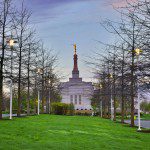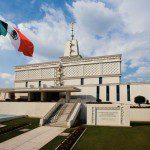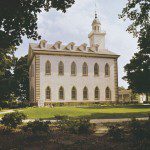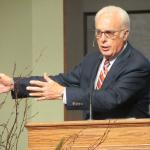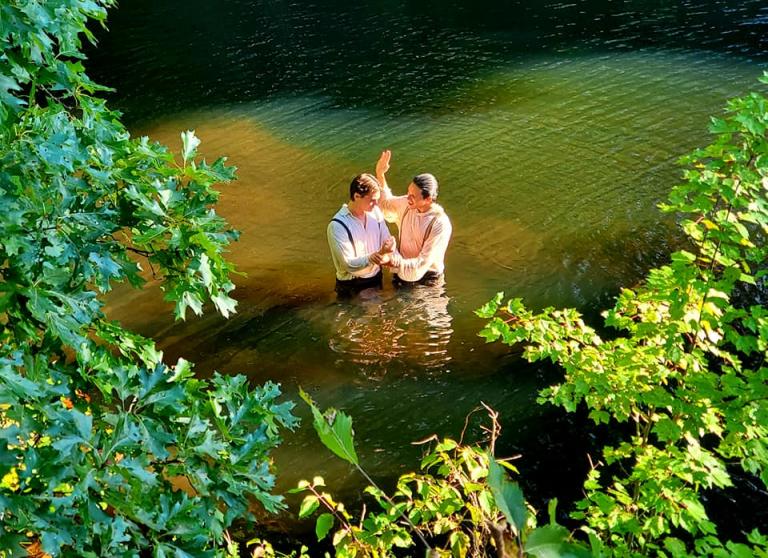
We had a long day today, including hours of driving (from Rochester, New York, to the site of early-nineteenth-century Harmony, Pennsylvania — in modern Oakland Township — and back up to Rochester). It was mostly Casey Griffiths’s and Steve Harper’s day, but I was also there, managing to bring the quality of the discussion down a bit. We highlighted reconstructed homes of Isaac and Elizabeth Hale and of Joseph and Emma (Hale) Smith, the (possible) baptismal site down on the bank of the Susquehanna River, and the McKune Cemetery, where the Hales are buried along with an infant son of Joseph and Emma.
On the way back, we drove through the impressive campus of Cornell University, where (by the way) we caught a glimpse of the pro-Palestinian tent encampment that has been erected on the Arts Quad. Cornell has evidently begun to suspend students who have refused to strike the tents and free up the quad.
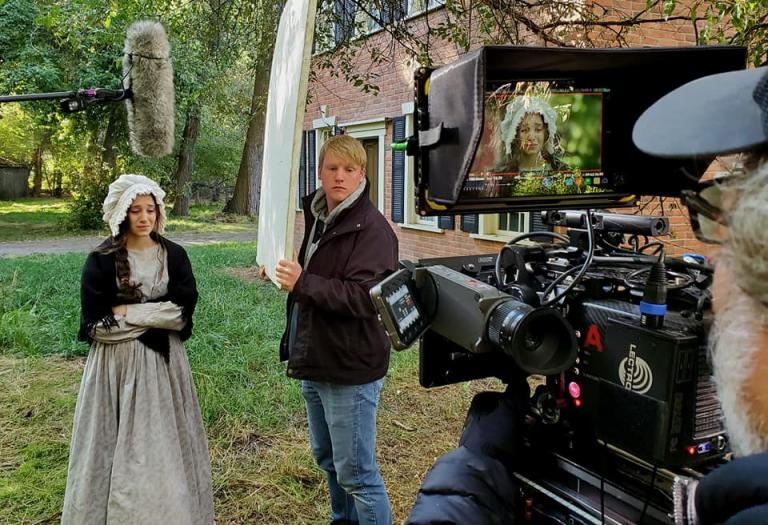
(Still photo by James Jordan from the set of the Interpreter Foundation’s 2021 movie, “Witnesses”)
Speaking of which (sort of): I came across the accusation today — I see it every once in a while — that the doctrines of the Church of Jesus Christ of Latter-day Saints resemble those of Islam more than those of Christianity. It’s a monumentally inane and ignorant declaration. But, as I say, it’s been a long day, and I’m tired; we returned to Rochester well after dark. So I will respond by recycling a very slightly modified version of something that I wrote some while ago in response to a prior assertion of the same risible claim. I could, of course, have listed literally scores of distinctions between the two faiths. (What, for instance, is the equivalent in Islam of, say, the Susquehanna River? Where is the Muslim place corresponding to the priesthood restoration site in Harmony?). But here are a few thoughts:
Back in 2012, when Mitt Romney was the Republican nominee for the presidency, a certain Ms. Eliza Wood took it upon herself to post an extraordinarily inept entry on Huffington Post entitled “Are Mormons Closer to Muslims or Christians?”
“In reality,” she said, “Islam is about as close to Christianity as Mormonism.”
Well, actually, No, it’s not. And I say this as a Latter-day Saint who is (or was) a professional Islamicist.
But a walk down memory lane will illustrate how, at least with some folks, ignorant anti-Mormonism harmonizes very nicely with anti-Islamic prejudice.
First of all, of course, Ms. Wood’s question is misconceived. It’s rather like asking whether Fords are closer to automobiles or water buffaloes. Fords are automobiles. And Latter-day Saints are Christians.
But perhaps Ms. Wood can’t really be blamed, because, quite plainly, she’s entirely unqualified even to have an opinion on the subject.
“Both Islam and Mormonism,” Ms. Wood declares, “have teachings from the Christian Bible and believe Jesus was ‘a prophet,’ but they had prophets after Jesus that they believe to be more authentic and current than Jesus.”
I have no idea what Ms. Wood means by “more authentic,” but I can’t really think of any significant sense in which any believing and reasonably intelligent Latter-day Saint would agree that Joseph Smith, or Brigham Young, or Russell M. Nelson, or any other modern prophet is “more authentic” than Jesus.
“More current”? Well, yes, but only in the trivial sense that Jesus lived out his mortal life in first century Palestine while President Nelson is alive right now, in the twenty-first.
But, anyway, while Islam regards Jesus as a very great prophet, he’s still a mortal and a creature and not divine. Latter-day Saints, by contrast, believe Jesus to be divine, the only begotten Son of God. That may be a small detail in Ms. Wood’s mind, but others might think that it deserved at least brief mention.
“Jesus’ teachings,” Ms. Wood somewhat obscurely says, “were a bit archived [???] in both because Muhammad and Joseph Smith were both visited by angels who told them to receive new orders from God. Both have respected Jesus’ messages but moved forward with other teachings and practices that are not consistent with Christianity.”
But this is merely to say that Latter-day Saint beliefs aren’t consistent with Ms. Wood’s version of Christianity, whatever that may be. It’s rather as if, defining squirrels as non-mammals, Ms. Wood were to point to the things that distinguish squirrels from giraffes, killer whales, and Bengal tigers as “not consistent with being mammals.” That would be not only rather eccentric but obviously circular.
“Islam teaches that Muhammad was the last prophet,” Ms. Wood informs her audience, “and Mormonism teaches that a line of prophets extended from Joseph Smith all the way to the present with Thomas S. Monson, who is currently considered their prophet.” [As I say, the article was published in 2012.]
Well, yes. But Ms. Wood doesn’t really explain how the fact that Islam believes the final prophet to have died in 632 AD, while the Church of Jesus Christ affirms that there is a living prophet on the earth today, supports her claim that the two religions are similar.
“While in some ways neither Islam nor Mormonism is very much like Christianity,” writes Ms. Wood, who has never actually defined Christianity, but who appears to believe that merely asserting that Latter-day Saint beliefs aren’t Christian does that work for her, “the two faiths actually have a lot of similarities. For example, both had founding prophets who received visits from an angel, leading to revelation of Scripture. Both consider the family unit as the foundation for religious life, and both have an insistence that religion is their complete way of life.”
Seriously? Insisting that religion is a complete way of life is scarcely unique to either Muslims or Latter-day Saints.
And, while both Islam and the Church of Jesus Christ consider family life important, their respective theologies of family bear only the most superficial resemblance to each other.
Yes, though, both religions do really include visits from angels within their founding stories. Among many thousands of potential similarities and differences, that’s one example of a similarity. But the stories and the roles of the angels are quite different in Islam and the Restored Gospel.
“Islam and Mormonism,” announces Ms. Wood, “both require fasting and ritual cleanings.”
But fasting and ritual cleansing (e.g., baptism) are common to religions worldwide, not merely to Islam and the Restoration.
“They both believe theirs is the original religion of Adam,” Ms. Wood writes.
But so, historically, have mainstream Christianity and Judaism.
“Both Islam and Mormonism,” says Ms. Wood, “allowed four wives but both forbid homosexuality and bisexuality.”
Historically, very few religions have traditionally celebrated homosexuality and bisexuality. It’s true, however, that both the Restoration and Islam have allowed polygamous marriages. Islam still does. Mormonism does not. But, while Islam limited men to four wives, “Mormonism” never did.
“Both religions,” Ms. Wood explains, “forbid alcohol and gambling.”
But the Restoration and Islam are scarcely unique in frowning upon gambling and alcohol!
“This may be alarming to some,” writes Ms. Wood, who very likely hopes that her readers will be alarmed, “but both Islam and Mormonism teach that marriage can extend into the afterlife.”
It’s not at all clear that Islam teaches a continuation of marriage into the afterlife.
And, by the way, it’s not clear why Ms. Wood finds the idea “alarming” that marriage might continue beyond the grave. Is she revealing something about herself? (And, by the way some critics insist that it is the Restored Church that separates husbands and wives at death; everybody else has always expected marriage to survive death — until the Latter-day Saints came along to rain on the parade.)
“Neither worships their founding prophets,” continues Ms. Wood, with remarkable charity, “but both hold them with special respect.”
Well, shiver me timbers and blow the house down! Judaism and mainstream Christianity, too, venerate ancient prophets and saints. Has she never heard of St. Peter’s Basilica? St. Paul’s Cathedral? Saint Patrick’s? Santa Ana, California? San Francisco? There’s nothing even remotely unique about regarding prophets, apostles, and saints with particular respect.
“Both religions heavily proselytize,” Ms. Wood writes, “and believe everyone should belong to their faith.”
Huh? Does Ms. Wood seriously believe that Christianity hasn’t been a missionary faith from its very beginning? Has she ever read the New Testament book of the Acts of the Apostles? What does she think St. Paul was doing on all those trips back and forth across Anatolia and the Mediterranean? Relaxing on the Lido Deck of a luxury cruise ship?
Posted from Rochester, New York


